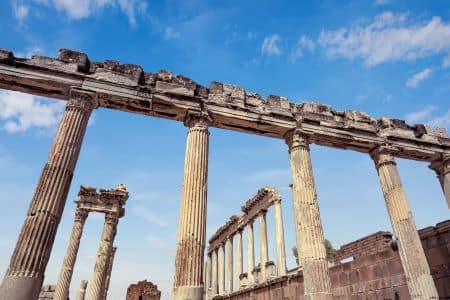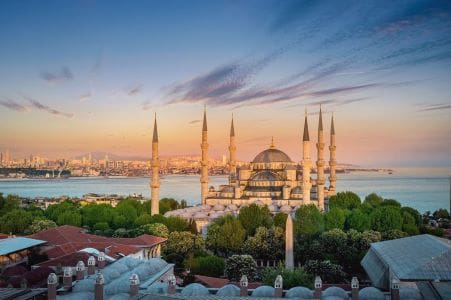Türkiye is known for its rich history and culture. It boasts 21 UNESCO World Heritage Sites offering valuable insights into Türkiye’s fascinating history. Explore the historic wonders of Türkiye and connect with the nation’s heritage by exploring its ancient ruins, stunning landscapes, and vibrant cultural traditions.
Overview of UNESCO World Heritage Sites in Türkiye

The UNESCO World Heritage Sites located in Türkiye highlight significant milestones in human history, guiding us through a fascinating journey from prehistoric times to the Middle Ages.
These sites reflect Türkiye’s rich culture, each telling a fascinating story. From the historic areas of Istanbul to the ancient city of Troy and the layered city of Pergamum, they give us a better understanding of the country’s history.
In essence, Türkiye’s UNESCO World Heritage Sites are not just reminders of the past but also crucial for the future, helping us pass on knowledge from one generation to the next.
We’ve picked some of the most famous UNESCO World Heritage Sites in Türkiye for you to see. Each site gives you a unique look into the country’s history, culture, and heritage.
Troy
Troy is a famous historical site with deep connections to Anatolia’s ancient past, dating back 4,000 years. It’s a UNESCO World Heritage site, famously mentioned in Homer’s Iliad, and is located along Türkiye’s Aegean coast.
Heinrich Schliemann discovered Troy in 1870, a major milestone in archaeology. His findings revealed many treasures that showed how different civilizations lived in this fertile area over thousands of years. Each artifact, wall, and gate tells part of Troy’s important story.
At its height, Troy formed a cultural link between the societies of Anatolia and the Mediterranean. The interactions between these cultures have left a lasting impact, making Troy a symbol of cultural heritage.
The tale of the Achaean warriors attacking Troy has inspired countless artists and storytellers. This cultural influence continues today, adding to Troy’s lasting appeal. Each visit to Troy is a fascinating journey through Türkiye’s history.
Ephesus
Ephesus is an ancient city located by the old River Kaystros. This amazing place features a mix of Hellenistic and Roman settlements that developed as the coastline moved westward.
Ephesus is home to impressive Roman monuments, such as the beautiful Library of Celsus and the Great Theatre, both showcasing the city’s former glory. Just seven kilometers away is the famous House of the Virgin Mary, a chapel that’s been a Christian pilgrimage site since the 5th century. The ancient city highlights the splendor of a Roman port, complete with a well-planned sea channel and harbor basin that reflect its architectural achievements.
This city also includes the ruins of the Temple of Artemis, one of the “Seven Wonders of the World,” which drew visitors from all over the Mediterranean. Even though it is in ruins now, the Temple of Artemis still holds significant meaning. It symbolizes Türkiye’s rich religious, architectural, and historical background. Surrounded by stork nests today, the pillars of the temple give a sense of timelessness, reflecting the greatness of Ephesian Artemis, originally an Anatolian mother goddess.As a UNESCO World Heritage Site, Ephesus is rich in history and offers a unique chance to explore Türkiye’s enduring treasures.
Historic Areas of Istanbul

You can start exploring Istanbul’s historic areas by visiting the Sultan Ahmed Mosque, also known as the Blue Mosque. When you enter this beautiful building from the 17th century, you’ll see fantastic architecture that reflects Türkiye’s rich culture. This UNESCO World Heritage Site reflects the artistic talent of the Ottoman period.
Inside, you’ll find a stunning sea of blue tiles, which is why it’s called the Blue Mosque. The large central dome, surrounded by smaller domes, showcases a blend of Islamic tradition and unique design. Each tile, geometric pattern, and piece of calligraphy highlights the skill of Ottoman artisans.
The Blue Mosque is more than just a place to worship; it represents Ottoman heritage and tells a deeper cultural story. It is a significant part of Türkiye’s shared history.
This stunning building is a perfect example of Ottoman architecture and culture and has become a timeless treasure. During your visit, you get the chance to immerse yourself in the incredible stories this magnificent mosque has to share.
Hagia Sophia is another famous building in Istanbul with a rich history that reflects a blend of various cultural influences. This beautiful structure features a large dome, detailed mosaics, and tall minarets, highlighting Eastern Roman (Byzantine) architecture. It has been a church, a mosque, and now a museum, representing centuries of religious and cultural exchange.

Hagia Sophia is not just stunning to look at; it also symbolizes the mix between different civilizations. It has been essential to Orthodox Christianity and reflects the greatness of the Eastern Roman/Byzantine and Ottoman Empires. As a museum, it celebrates the blend of Orthodox and Islamic influences. Hagia Sophia presents a great opportunity to discover Türkiye’s rich cultural heritage.
Hagia Sophia is recognized by UNESCO as part of the Historic Areas of Istanbul, a designated World Heritage Site. This organization aims to preserve its religious, cultural, and architectural significance. Together, UNESCO and Türkiye are committed to maintaining Hagia Sophia’s uniqueness so future generations can appreciate and learn from it.
Connecting Civilizations Through Time
Türkiye’s World Heritage Sites are essential symbols of people’s achievements. Each site tells us about Türkiye’s rich history and connects us with people from the past. These sites are more than mere architectural wonders or relics; they are vibrant testaments to human creativity and resilience. They represent past civilizations and share stories, linking us to Türkiye’s cultural heritage.
Nathaniel Clark